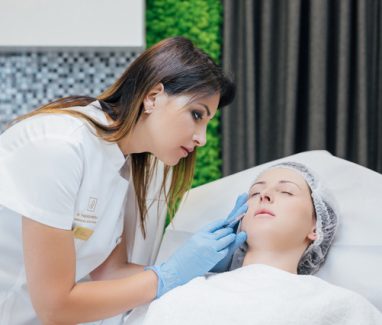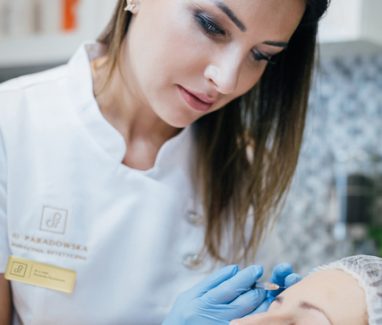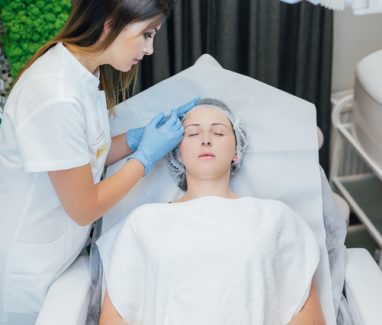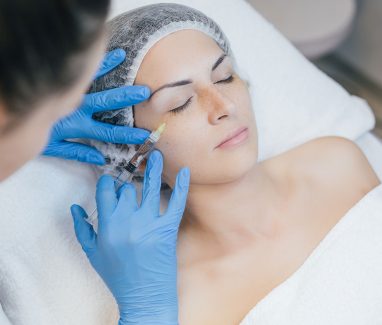The so-called fillers are currently widely used in aesthetic medicine. They allow for a relatively quick and safe restoration of the youthful appearance, in comparison, for example, to traditional face lifting procedures. Most fillers can shallow wrinkles and furrows in less than 30 minutes, and the results of the treatment last from 4 months to over a year. In many cases, the effects are spectacular and allow for a restoration of a youthful, healthy look and radiant, smooth complexion. Fillers work in a different way than botox, which relaxes the muscles under the wrinkles on the skin. The effect of fillers, on the other hand, is the smoothing of the wrinkles themselves, thanks to which they become virtually invisible. Fillers are also used in modelling and increasing the volume of some parts of the face like cheeks, chin, temples or lips. They are also used to correct tear trough deformities and dark circles under the eyes. Some fillers can also be used to treat acne scars or HIV-associated lipoatrophy.
Filler based treatment is fast, relatively simple and easily accessible. However, like all products used in aesthetic medicine, they are associated with a particular risk of complications. Possible side effects include allergic reactions and the formation of subcutaneous nodules. Sometimes, there might appear a blue discolouration of the skin, called the Tyndall effect, which may persist for several months. In rare cases, incorrect administration of the filler may lead to tissue necrosis. There were also isolated cases of nerve damage.
Types of fillers
Below we will focus on the different types of fillers that we offer in our Clinic. Each of them allows to achieve a slightly different effect and has a different duration. Our aesthetic medicine specialists will be happy to help you choose the right preparation, consult them in case of any doubts about the proper method of treatment.
One of the most popular fillers are products based on hyaluronic acid. Each of the preparations available on the market works slightly differently and allows you to achieve particular results. Side effects are rare and mainly include redness, swelling, and bruising at the injection site. Sometimes the preparation shows up in the form of subcutaneous lumps, which usually disappear with time. The duration of the hyaluronic acid effect can range from several months to up to two years. Some studies suggest that repeated injections of hyaluronic acid may stimulate the body to produce collagen, which reduces the appearance of wrinkles. An additional advantage is a possibility of using the enzyme hyaluronidase to dissolve hyaluronic acid with undesirable effects.
The preparations based on hyaluronic acid include:
- Stylage
- Teosyal
- Neauvia
- Hylaform
- Juvéderm
- Prevelle
- Restylane
There is a small group of fillers based on synthetic substances that do not naturally appear in the human body. Possible side effects are similar to those occurring with the usage of preparations based on hyaluronic acid. The advantage of this type of fillers is the longer duration of their effects. Unfortunately, with the lack of experience of the person administering the preparation, facial disfigurement and distortion may quickly occur.
The preparations based on synthetic fillers include:
- Bellafill
- Radiesse
- Sculptra
The first fillers developed by scientists were based on collagen extracted from cows. They were practical and allowed for obtaining natural outcomes, but they did not last for too long. In most cases, the preparations began to be absorbed about a month after the injection. Due to receiving them from animal products, the patients had a relatively high percentage of allergic reactions.
New collagen processing methods have reduced the risk of such side effects. There also appeared new forms of synthetic collagen, which are very safe for patients. The outcomes of collagen administration do not last as long as with other fillers, but their effect is subtle. Possible side effects are the same as with different types of fillers, i.e. an allergic reaction, redness or bruising at the injection site.
The preparations based on collagen include:
- Cosmoderm
- Evolence
- Fibrel
- Zyderm
- Zyplast
Of these type of fillers, adipose tissue is most commonly used. The fat from the thighs, buttocks or abdomen of the patient is removed and then properly prepared and injected into the desired place. Both procedures can be performed during one visit to the doctor. The results of this type of surgery may be short-lived, and the patient may require many injections. The undoubted advantage is that you can get rid of fat from unwanted places and at the same time, improve the appearance of the face.
Another type of autologous product used to fill tissues is platelet-rich plasma. It is often called „Vampire Lifting”, during which the doctor draws blood from the patient, then places it in the centrifuge. After receiving the platelet-rich plasma, it is injected into the face. The effects last for 12-18 months. This method is safe because the blood comes from the patient, which is why there is minimal risk of allergy.
Minimizing the risks associated with the use of fillers
Fillers used in aesthetic medicine are counted among very safe products. However, it’s worth following our tips below when choosing the right treatment:
- Do not be influenced only by the price of the procedure. If someone offers you filler injections at a price much lower than regular, the quality of the preparation or the skills of that person is probably insufficient.
- All procedures involving the injection of fillers should be performed under the sterile conditions of a doctor’s surgery. Do not agree on treatments at home, hotel or spa.
- Do not buy the preparations yourself, outside of the doctor’s office. Dishonest vendors can offer formulations containing industrial silicone or baby oil.
Contraindications
The general contraindications for the use of fillers are: a history of a severe allergic reaction or anaphylactic shock, coagulation disorders and hypersensitivity to any of the formulation’s ingredients. Inflammatory conditions, such as pimples, pustules or rashes in the treated spot are also contraindicated for this method of therapy.
Filler injection should not be done to pregnant women, breastfeeding women, people with cancer or autoimmune diseases, and with exacerbations of chronic diseases. The tendency to form keloids is also a contraindication for the use of fillers.
Relative contraindications include: recent use of aspirin, non-steroidal anti-inflammatory drugs or herbal supplements that can affect blood clotting processes.
How to proceed after the treatment
After injecting the fillers, intense physical activity should be avoided for approximately 24 hours. You also need to limit your skin’s exposure to the sun and use a sunscreen with a minimum of SPF 25. To reduce pain after the treatment, it is recommended to use cold compresses. Do not massage of touch the treated areas for 24 hours after the procedure to avoid displacement of the formulation. If bruises appear, apply a warm, moist compress. By using the services of aesthetic medicine specialists from our Clinic, you can rest assured that the treatment will be performed by a professional, using products of the highest quality and in sterile conditions. It is not worth risking your health and appearance, by choosing random, unskilled people or products of unknown origin for carrying out the procedure.





